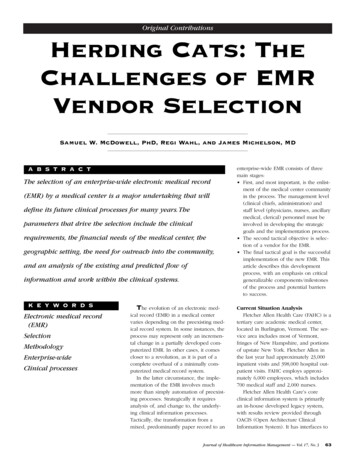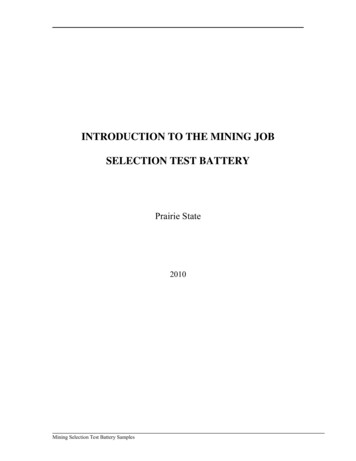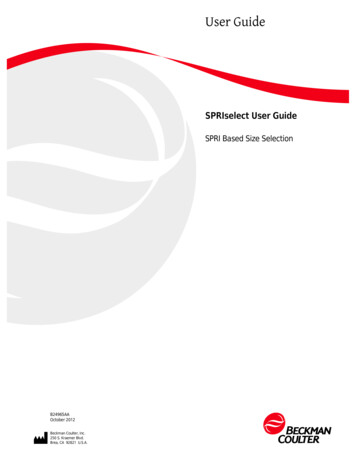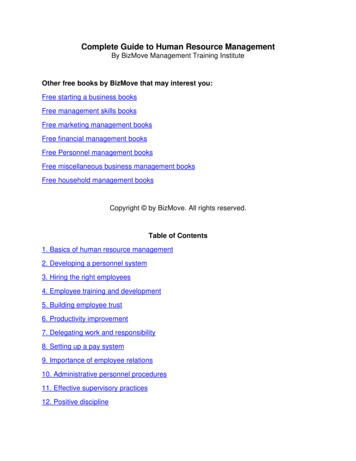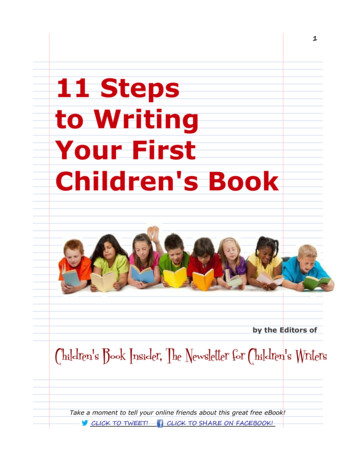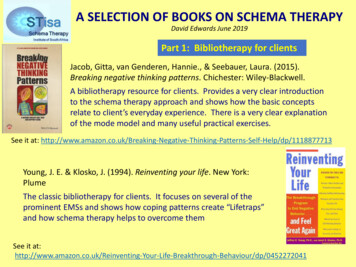
Transcription
A SELECTION OF BOOKS ON SCHEMA THERAPYDavid Edwards June 2019Part 1: Bibliotherapy for clientsJacob, Gitta, van Genderen, Hannie., & Seebauer, Laura. (2015).Breaking negative thinking patterns. Chichester: Wiley-Blackwell.A bibliotherapy resource for clients. Provides a very clear introductionto the schema therapy approach and shows how the basic conceptsrelate to client’s everyday experience. There is a very clear explanationof the mode model and many useful practical exercises.See it at: -Patterns-Self-Help/dp/1118877713Young, J. E. & Klosko, J. (1994). Reinventing your life. New York:PlumeThe classic bibliotherapy for clients. It focuses on several of theprominent EMSs and shows how coping patterns create “Lifetraps”and how schema therapy helps to overcome themSee it reakthrough-Behaviour/dp/0452272041
Books on schema therapy page 2Skeen, M. (2014). Love me don’t leave me: Overcoming fear ofabandonment and building lasting, loving relationships. OaklandCA: New Harbinger.A self-help book that focuses on primary Vulnerable Childschemas: Abandonment, Emotional Deprivation, Mistrust/Abuse,Defectiveness and Failure. Takes the reader through the process oftriggering, learning to be aware and mindful, developing selfcompassion and replacing dysfunctional coping with more maturebehaviour. Foreword by Wendy Behary, former ISST President.See it at: t-Relationships/dp/1608829529/Skeen, M. (2011). The critical partner: How to end the cycle of criticismand get the love you want. Oakland CA: New Harbinger.A schema therapy perspective on a critical partner and the earlymaladaptive schemas that may be driving his or her critical behaviour.Also looks at the partner on the receiving end of the criticism and theearly maladaptive schemas he or she is likely to have. Understandingthis can lead to a plan to make meaningful changes.See it tner-Cycle-Criticism/dp/1608820270
Books on schema therapy page 3Behary, W. (2013). Disarming the narcissist. Surviving andthriving with the self-absorbed (2nd ed). Oakland CA: NewHarbinger.New edition of a helpful book for therapists and clients whohave to deal with narcissistic individuals. An excellent andaccessible account of the schema therapy approach this kind ofpersonality.See it rviving-Thriving-SelfAbsorbed/dp/1608827607Love, C. V. (2012). No more narcissists! How to stop choosing selfabsorbed men and find the love you deserve. Oakland CA: NewHarbinger.Presents an understanding of narcissists within the schema therapyframework showing how lifetraps (as presented in Reinventing yourlife) and early maladaptive schemas contribute to individuals fallingprey to self-centred and exploitative partners. Very practical with afocus on steps to take to bring about meaningful change, including thepractice of mindfulness meditation.See it oosing-Self-Absorbed-ebook/dp/B0197SJPWY/
Books on schema therapy page 3McKay, M., Lev, A., & Skeen, M. (2012).Acceptance and commitment therapy forinterpersonal problems: Using mindfulness,acceptance and schema awareness tochange interpersonal behaviors. OaklandCA: New Harbinger.A self-help book that focuses on how selfdefeating ways of coping with earlyschemas undermine interpersonalrelationships and how to become moreself-aware and bring about meaningfulchange using methods from acceptanceand commitment therapy and schematherapy.See it Therapy-Interpersonal-Problems/dp/1608822893/
Books on schema therapy page 4Louis, J.P. & Louis, K. M. (2015). Good enough parenting. New York:Morgan James.A wonderful summary of current attachment theory-informed parenttraining framed within the schema therapy approach. For parentswho want to understand how to effectively parent their children. Forclients who were misparented to help them understand what wentwrong and what they still need. And for schema therapists to remindus what is involved in offering reparenting to clients.See it epth-Exasperation/dp/1630474061/Bruce Stevens and Eckhard Roediger E. (2016). Breaking negativerelationship patterns: a schema therapy self-help and support book.Chichester: Wiley-Blackwell.An introduction to the schema therapy approach to working withcouples. This very practical book shows how schema therapy conceptsare applied in understanding conflicts in couple relationship and howthey provide helpful ways of thinking about what is needed to bringabout meaningful and lasting change.See it tionship-Patterns-Self-Help/dp/1119162823
Books on schema therapy page 5Bennett-Goleman, T. (2001). Emotional alchemy: How your mind canheal your heart. London: Rider.A self help book that incorporates concepts from schema therapyand mindfulness meditationSee it at: 0438Bennett-Goleman, T. (2013). Mind whispering: A new map tofreedom from self-defeating emotional habits. London: Rider.Tara Bennett-Goleman’s more recent self help book thatincorporates further concepts from mindfulness meditation,neuroscience and schema therapy (including schema modes).See it LID37277543(eBook version)
Part 2: Books for therapistsBooks on schema therapy page 6Young, J. E., Klosko, J., & Weishaar, M. E. (2003). Schema therapy: Apractitioner's guide. New York: Guilford.A comprehensive account of schema therapy and its developmentfrom Jeff Young and colleagues. It provides the theoretical foundationfor schema therapy as well as how to do it in practice. Available inhardback or paperback.See it at: rs-Jeffrey-Young/dp/1593853726Arntz, A. & Jacob, G. (2012). Schema Therapy in practice. Oxford:Wiley/Blackwell.A practical guide to working with schemas and schema modes. Anexcellent introduction to the practical application of the schemamode model with many case examples from a range of personalitydisorders as well as anxiety, depression and OCD.See it -Introductory-Approach/dp/1119962862/
Books on schema therapy page 7Rafaeli, E., Bernstein, D. P. & Young, J. (2011) Schema Therapy(The CBT Distinctive features series). London: Routledge.A brief well organized introduction that covers all the importantconcepts.See it inctive-Features/dp/0415462991/Roediger, E., Stevens, B. A., & Brockman, R. (2018). Contextual schematherapy: An integrative approach to personality disorders, emotionaldysregulation, and interpersonal functioning. Oakland, CA: NewHarbinger.Drawing on Acceptance and Commitment Therapy and otherapproaches, the authors show how important concepts andinterventions, such as mentalization, mindfulness, acceptance,metacognition and human values, can be integrated into the basicschema therapy model. Indeed, many of them are already explicit orimplicit in it. In addition to showing the integrative power of theschema therapy model, this book offers a fresh and readable accountof its central ideas as well as rich clinical examples of their application,all well-grounded in the current academic and clinical literature.See it at: -Dysregulation-Interpersonal/dp/1684030951/Or y-Dysregulation-Interpersonal/dp/1684030951/
Books on schema therapy page 8Farrell, J. M. and Shaw, I. A. (2018). Experiencing schematherapy from the inside out: A self-practice/self-reflectionworkbook for therapists. New York: Guilford.Like most forms of psychotherapy, schema therapy is notjust a set of techniques applied to patients by therapists in amechanical way. Therapy depends on building a personalrelationship with clients and that calls for the schematherapists to develop their own self-awareness, openness toexperience, and capacity to identify and work with theirown psychological issues. This workbook provides a usefulpractical guide to this. There’s a clear account of theschema therapy model and how to work with modes.Therapists who use this book will learn more aboutthemselves in a way that they can directly apply to theirwork with clients.See it at: py-Inside-Psychotherapists/dp/1462533280/or: -Inside-Psychotherapists/dp/1462533280/or: iencing-schema-therapy-from-the-in/kdcn-4975-g6a0
Books on schema therapy page 8Simpson, S. and Smith, E. (Eds) (2019). Schematherapy for eating disorders: Theory, practice andgroup treatment manual. Abingdon, UK: Routledge.Schema therapy has been applied to eating disordersfor some 20 years and there are many articles in theacademic literature. This book is an up to dateclinicians guide based on what has been learned byschema therapists working with eating disorders. Itprovides a theoretical understanding of caseconceptualization in eating disorders and theprominent schema modes that are encountered. It isrich in clinical examples and a source for the kinds ofinterventions that are most helpful. Also providesguidelines for a group treatment approach as well asfor individual therapy. Available in August 2019.See it at: orders-Group-treatment/dp/0367272407/
Books on schema therapy page 9Farrell, J.M., Reis, N., & Shaw, J. (2014). The schema therapyclinician’s guide: A complete resource for building and deliveringindividual, group and integrated schema mode treatmentprograms. Chichester: Wiley-Blackwell.Full of clinical examples that provide readers with a grounded andaccessible sense of what schema therapy is all about and how toput it into practice. There is a clear structure and a wealth ofresources for its implementation including worksheets and scriptsfor therapists to use at different stages or for different purposes.See it at: Guide-Delivering/dp/111850917XFarrell, J. M. & Shaw, I. A. (2012). Group schema therapy forborderline personality disorder: A step-by-step treatmentmanual with patient workbook. Chichester: Wiley.Joan Farrell and Ida Shaw developed group schema therapy, avery distinctive form of group therapy for patients withborderline personality disorder. This manual providesguidelines on how to do it.See it at: Personality-Disorder/dp/1119958296
Books on schema therapy page 10van Vreeswijk, M., Broersen, J. & Nadort, M. (2012).The Wiley-Blackwellhandbook of schema therapy: Theory, research and practice. Chichester:Wiley.Over 600 pages and over 40 chapters covering the spectrum of theory andpractice. There’s a chapter by myself and Arnoud Arntz on the history of schematherapy and chapters on a wide range of topics from case conceptualization toimagery and chairwork, to depression, eating disorders, OCD, and variouspersonality disorders including narcissistic and antisocial. There are severalchapters on incorporating mindfulness meditation, on group schema therapyschema therapy for couples and the current evidence base for the effectiveness ofSee it at:schema therapy. Expensive ndbook-Schema-Therapy-Research/dp/047097561XRiso, L. P. du Toit, P. L., Stein, D. J. & Young J. E. (Eds.) (2007).Cognitive schemas and core beliefs in psychological problems: Ascientist-practitioner guide (pp. 139-175). Washington DC:American Psychological Association.A research resource, not exclusively on schema therapy. Thereare good chapters on schema based conceptualization for arange of clinical problems including depression, OCD, PTSD,substance abuse, eating disorders, psychosis and discord incouples.See it fs-Psychological-Problems/dp/1591477824
Books on schema therapy page 11Simeone-DiFrancesco, C., Roediger E., and Stevens, B. (2015). Schematherapy with couples: A practitioner’s guide to healing relationships.Chichester: Wiley-Blackwell.An in depth presentation of the schema therapy approach to workingwith couples. An international collaboration between authors from theUSA, Germany and Australia that draws on their own experiences aswell as insights from discussions with an international online group ofschema therapists pioneering the application of schema therapy tocouples’ therapy.See it Practitioners-Relationships/dp/1118972678Van Vrieswijk,M., Broersen, J., Schurink,G. (2014). Mindfulness andSchema Therapy: A Practical Guide.Provides a basic guide to the steps of mindfulness practice andhow the practice can help with the identification of schema modesand therapeutic work with them.See it rapy-Practical-Guide/dp/1118753178/
Books on schema therapy page 12Arntz, A. & van Genderen, H. (2009). Schema Therapy forBorderline Personality Disorders. Oxford: Wiley/Blackwell.Based on methods developed for the Dutch clinical trial ofschema therapy, this book describes the basic concepts and manypractical and useful techniques that can be incorporated intoschema therapy.See it ne-Personality-Disorders/dp/0470510803/Young, J. E. (1999). Cognitive therapy for personality disorders: Aschema-focused approach. (3rd ed.) Sarasota FL: Professional ResourcePress.Third edition of Jeffrey Young’s first book on schema therapy (firstedition published in 1989). Still worth reading as the concepts are builtround a very clear case study. Much of the material has beenincorporated into Young, Klosko & Weishaar (2003).See it nality-Disorders-Schema-Focused/dp/1568870477
Part 3: Books in GermanBooks on schema therapy page 13There is a large number of other original books in German (andDutch). Here are just some examples:Loose, C., Graaf, P., & Zarbock, G. (2013). Schematherapie mit Kindern undJugendlichen. Basel: Beltz.Christof Loose and colleagues’ influential book on schema therapy for children andadolescents. The English translation is on its way and eagerly awaited!See it Jugendlichen-Christof-Loose/dp/3621280146/Zarbock, G. (2014). Einladung zur Schematherapie: Grundlagen, Konzepte, Anwendung.Basel: Beltz.A book that focuses on how to develop as a schema therapist.See it rapie-GrundlagenAnwendung/dp/3621281347/Roediger, E, (2011). Praxis der Schematherapie: Lehrbuch zu Grundlagen, Modell undAnwendung (2nd edition). Schattauer Gmbh.This well established manual is already into its second edition.See it ehrbuch-GrundlagenAnwendung/dp/3794527674
Disarming the narcissist. Surviving and thriving with the self-absorbed (2nd ed). Oakland CA: New Harbinger. New edition of a helpful book for therapists and clients who have to deal with narcissistic individuals. An excellent and accessible account of the schema therapy approach this kind of personality. Love, C. V. (2012). No more narcissists!


